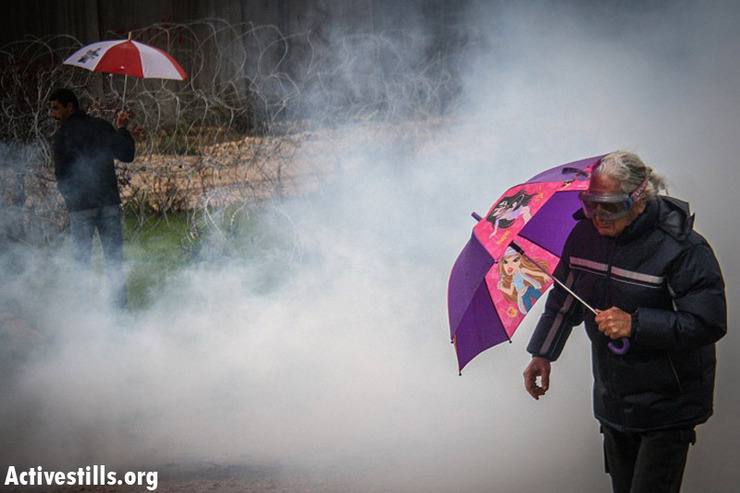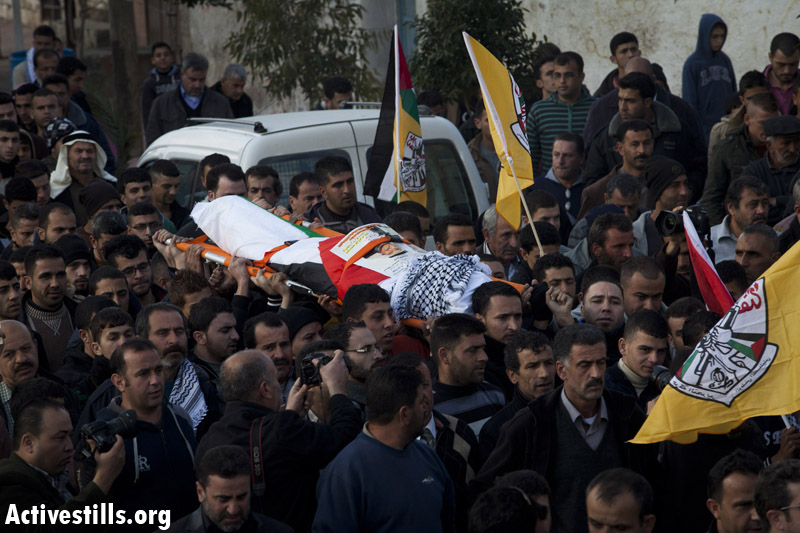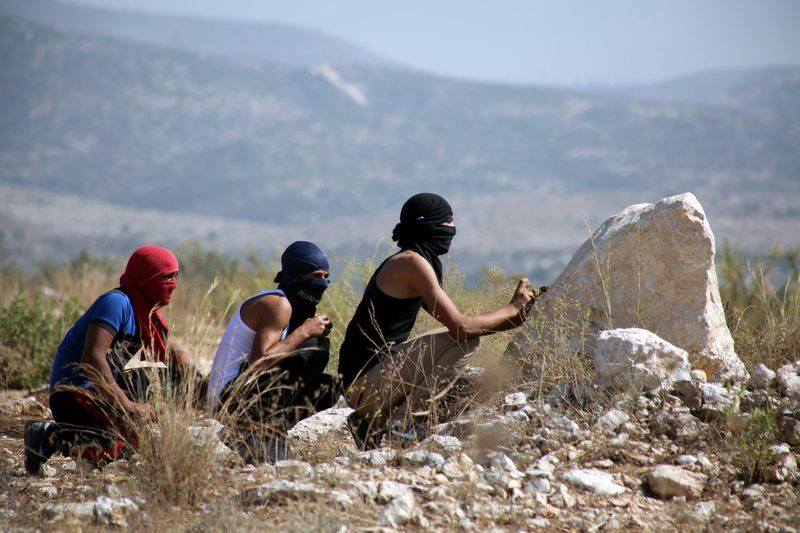A decade ago popular protests against the separation wall, settlements, and occupation were the great promise of the Palestinian struggle. Now a new book takes a look at why these demonstrations were never actually able to bring out the Palestinian masses to the streets, and what activists can learn for the future.
By Thimna Bunte

In what may be the most insightful, comprehensive, and sensitive academic study of today’s Palestinian popular resistance, Marwan Darweish and Andrew Rigby’s new book, Popular Protest in Palestine – The Uncertain Future of Unarmed Resistance, provides an excellent analysis of Palestinian unarmed resistance to the Israeli occupation, and the reasons why it has not developed into a popular, mass movement. Woven into their overview is an analysis of Palestinian unarmed resistance in a different role — one that opens the possibility of identifying new and more effective strategies, and thereby a potential for hope.
The decline of Palestinian unarmed resistance
“’We came alive in the First Intifada. Then we died in the second. Maybe now we are being reborn.’” Such was the spirit of hope among large segments of the Palestinian population in the wake of popular unarmed resistance to the separation wall and the settlements following the Second Intifada. Examining this movement in the decade leading up to 2014, Darweish and Rigby reveal the obvious: despite some success stories, unarmed resistance by Palestinians failed to develop into a popular mass movement of civil resistance to Israel’s military occupation. Rather, unarmed resistance in Palestine seems to be “localised pockets of resistance […] in response to immediate threats to the well-being and way of life of local people.” The conviction that popular resistance can bring about an end to the occupation has long turned into a feeling of disappointment and frustration among Palestinians, and specifically the activist community.
In the authors’ interviews with more than 100 Palestinian and Israeli activists and politicians, it becomes apparent that the Palestinian activists are fully aware of the fundamental weaknesses of the civil resistance movement. They point to the political fracture between parties and within movements; the absence of a coherent strategy; the lack of coordination between competing networks of activists, as well as the lack of trust in leadership at any level. In order to understand why these weaknesses exist, Darweish and Rigby analyze different phases of Palestinian unarmed resistance from the late 19th century with an understanding of the necessary conditions for a sustainable unarmed resistance movement.

Some of those conditions — including instance a strong sense of solidarity and unity, well-organized networks of community-based organizations, and a unified leadership — were present during the First Intifada. However, “these conditions were undermined and eroded over the two decades of the Oslo Peace Process such that there was no longer the necessary socio-political base for a mass movement of popular resistance.”
Thus, Darweish and Rigby identify three major challenges for Palestinian unarmed resistance today. First, geographical fractures introduced by the Oslo Accords, economic impoverishment, the NGOization of community-based organizations, and the public’s disillusionment with the Palestinian Authority and a divided political leadership eroded any significant sense of solidarity amongst Palestinians.
Second, rather than having a unified body leading the struggle, like in the First Intifada, today there are rival coordinating bodies that compete over actions, media presence, and funding.

Third, there is no effective popular resistance strategy shared by the movement, displaying a positive vision and the approaches on how to reach it. Part of this challenge, as the authors point out, is that the once important strategic goal of exerting direct leverage over the Israeli population is scarcely possible anymore.
While their analysis of previous and current dynamics and challenges is discouraging, Darweish and Rigby see ground for hope in the increasing third-party solidarity by external actors. Thus, they suggest an understanding of Palestinian unarmed resistance as part of a chain of influence, in which third parties exercise leverage over the Israeli public and decision-makers.
The boomerang pattern
The idea is simple: currently Palestinian unarmed resistance cannot effectively reach Israeli society or decision-makers who could end the occupation. However, it can influence external solidarity actors who then reach out to their own societies, governments, NGOs and the international community. Those, in turn, have the power to influence the Israeli public and decision-makers.

Ideally, this would unleash what Darweish and Rigby call a “boomerang pattern.” Because neither the Israel government nor society is responsive to Palestinian unarmed resistance in the desired way, the activists “’throw a boomerang’ out to external actors and networks naming and shaming their oppressors, in the hope that the boomerang will return and hit their target with international pressure, particularly from international allies of the targeted regime.” The authors correctly state that such chains of influence already exist, most significantly with the boycott, divestment, and sanctions movement (BDS), which was established 2005. However, in order for the boomerang effect to work successfully, hopes should not only be put in outside actors. Palestinian unarmed resistance, international solidarity, financial institutions and governments all need to do their part in making the occupation too costly for Israel. Interestingly, in their conclusion, the authors only give recommendations for the Palestinian part of the chain.
Darweish and Rigby hesitate to assert that a boomerang pattern is likely to succeed. Nevertheless, with this understanding they offer something beyond a convincing strategic outlook — they offer a valuable contribution in countering the frustration within popular resistance. The significance of suggesting the understanding of Palestinian unarmed resistance as one part of a chain of influence is that it moves away from the perception of failure to end the occupation towards an understanding of popular resistance in the role of an already emerging boomerang thrower. If Palestinian unarmed resistance decided to understand itself more in this role, it could build up more effectively on its already existing expertise as activists and advocates. This can be a valuable impulse for Palestinian activists in their own strategizing process and role definition – and it can be grounds for hope.
Incomplete pieces: Analysis of Israeli and int’l movements

In a book focusing on popular struggle in Palestine, it is understandable that Darweish and Rigby focus their analysis on Palestinian resistance. It is a pity, however, that they do not use the valuable information they gathered on Israeli activism, international humanitarian aid agencies, and international solidarity in the same fruitful and inspiring way as they do for Palestinian resistance. For example, the authors’ analysis framework looks at the conditions for sustainable unarmed resistance movements for the Palestinian movement alone, but not for their analyses of Israeli and international solidarity movements or humanitarian aid agencies.
An analysis of the reasons why Israeli or international activists so far have failed to build up a sustainable movement that brings about an end of occupation could have been valuable for Israeli and international activists’ strategizing. In addition, the authors give an insightful overview of the dynamics within Israeli movements, their modes of engagement, and the challenges they face, as well as the contributions and shortcomings of humanitarian aid agencies. Furthermore, the authors could have moved beyond a general description of actors and forms of engagement and provided more substantial suggestions for Israeli and international solidarity activists, and aid agencies on how to define and more effectively see through their role in a boomerang pattern.
Still, Darweish and Rigby succeeded in publishing the best available analysis of today’s Palestinian popular resistance movement against the wall and the settlements. They offer meaningful impulses for discussion for the Palestinian movement and their strategizing processes as well as potential for hope. In all, Popular Protest in Palestine is a highly recommended read for Palestinian, Israeli, and international solidarity activists. It now remains to be seen if and how they pick up on these insights and use them to move from a perception of failure toward a different strategic understanding of their role in ending the Israeli occupation – toward hope for change.
Popular Protest in Palestine – The Uncertain Future of Unarmed Resistance was published in 2015 on Pluto Press. Find it here.
Thimna Bunte has been involved in various nonviolent initiatives in the occupied territories since 2011. She is active with KURVE Wustrow — Center for Training and Networking Nonviolent Action. This article was first published in Hebrew on Local Call. Read it here.
